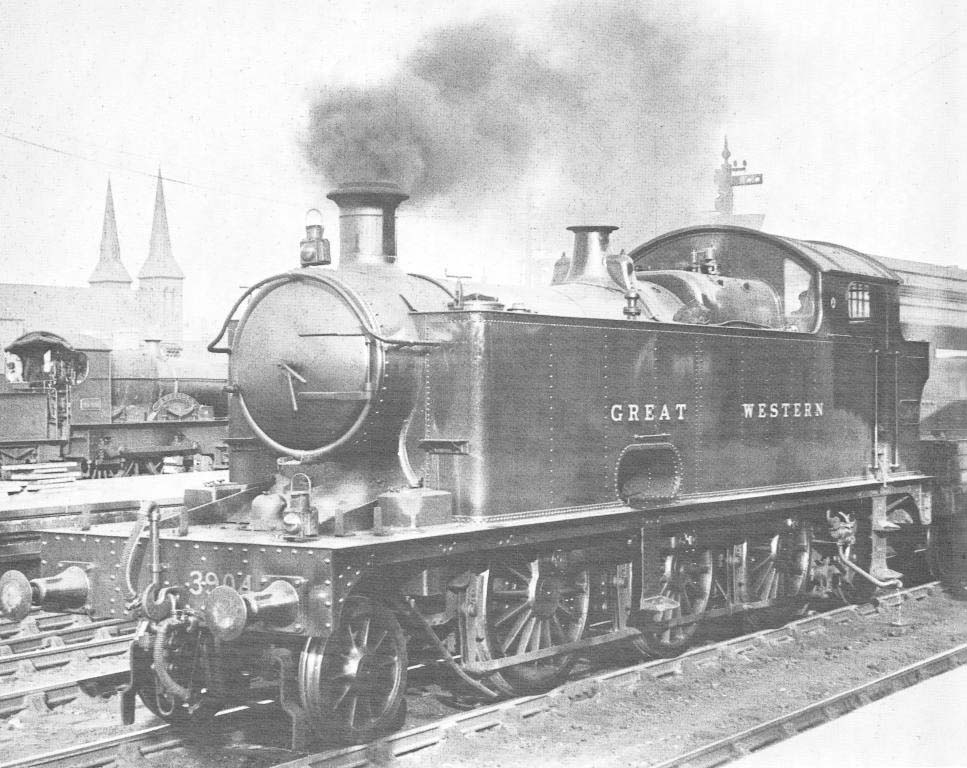 |
|
GWR Route: Banbury to Wolverhampton
GWR Route: North Warwickshire Line
Birmingham Snow Hill Station: gwrbsh1765
 |
Great Western Railway 39xx class 2-6-2T No 3904 with a class
E express freight train on the down centre road at the north end of Snow Hill
station in 1929. In the background is Birmingham's Catholic Cathedral. No 3904
was built as Dean Goods 0-6-0 tender locomotive No 2504 in October 1896 and
converted to a tender locomotive in May 1907. At this time there was a demand
for more powerful suburban locomotives especially in Birmingham where the North
Warwickshire Line was soon to open. With the Swindon Works machine shops
operating at full capacity, these rebuilds used all the principle parts of
twenty surplus Dean Goods locomotives on new frames with a Churchward standard
No 5 boiler and two 750 gallon side tanks to produce these unusual looking
prairie tank conversions. The locomotive had inside cylinders and the large
unsightly hole in the side tank gave access to the motion for oiling. The
boiler operated at a pressure of 200 lbs producing a tractive effort at 85% of
20,155 lb and these locomotives were classified in power group B. The maximum
axle weight was 17 tons 4 cwt restricting the locomotives to main lines and
some branch lines (colour code – Blue). All the conversions were built
without superheaters, but No 3904 had one fitted in August 1914. Other
modifications included; fitting top-feed apparatus, enlarging the rear bunker
to increase coal capacity (around 1920) and fitting of Automatic Train Control
(ATC) around 1931.
These locomotives were designed for the Birmingham suburban
traffic and No 3904 was known to have been allocated to Tyseley shed (TYS) in
both January 1921 and May 1922. By 1929 most had been displaced by the new
2-6-2T locomotives and No 3904 was withdrawn from Neath shed (NEA) in south
Wales in October 1933. The other locomotive in the photograph is Great Western
Railway ‘Flower’ class 4-4-0 No 4149 ‘Auricula’. This
locomotive was built as No 4101 at Swindon Works in May 1908, as the first
locomotive in lot 176. There were twenty locomotives in the flower class and
they were said to be the favourites of George Churchward, the Chief Mechanical
Engineer, who was a keen horticulturist. The numbers were changed in December
1912 as part of the general renumbering scheme designed to group locomotives of
a similar power together. No 4149 carried a three quarters coned (type D3)
Standard No 2 boiler with a Belpaire firebox. The locomotive was fitted with
superheating in April 1911 and top-feed apparatus in the same year. The boiler
operated at 195 lbs to give a tractive effort, at 85%, of 17,345 lbs and the
locomotive was classified in power group A. The deep frames resulted in a heavy
locomotive with a maximum axle weight was 18 tons, so it was restricted to main
lines and a few branch lines (Colour code – Red). These locomotives were
initially allocated to south Wales sheds to operate fast passenger services on
Cross Country routes, such as Fishguard to Cardiff and Cardiff to Salisbury.
Later they were used on short semi fast services including; Birmingham to
Leamington, Oxford, Cardiff or Swansea. In January 1921, No 4149 was known to
have been allocated to Goodwick shed (FGD) at Fishguard, while in May 1922 was
allocated to Cardiff shed (CDF). In 1929, No 4149 was withdrawn from Leamington
shed (LMTN).
Robert Ferris
 back back

|
